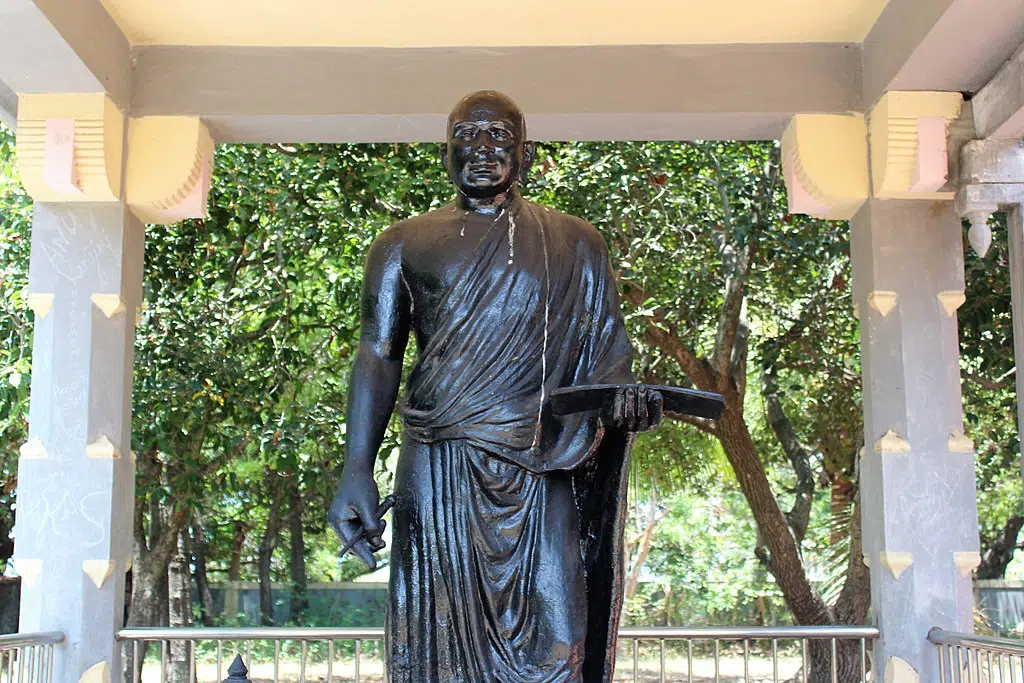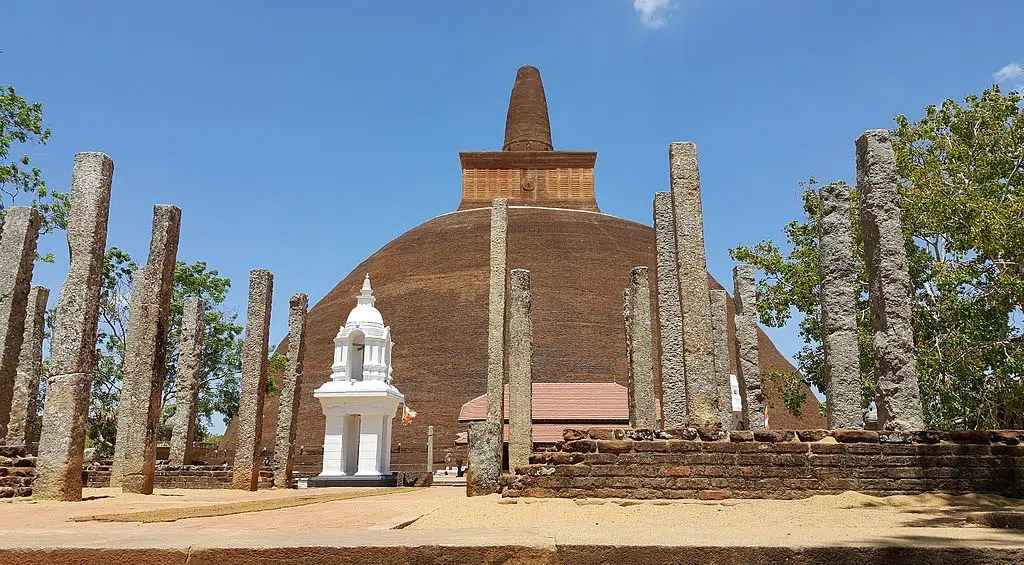
There was a time when ancient Greeks from the Indo-Greek empire in North India started migrating to Tamil Nadu. This is their saga:
In the extreme South of the Indian Sub-continent is a state known as Tamil Nadu, land of the Tamils. Tamils are a Dravidian people, who speak a language which, according to some, is the oldest surviving language still spoken in the world. A broken storage jar with inscriptions in Tamil Brahmi script (written in a combination of Tamil and the Brahmi script) has been excavated at Quseir-al-Qadim, an ancient port with a Roman settlement on the Red Sea coast of Egypt.
Tamils have made a phenomenal contribution to Asian history from antiquity to the present time. The Chola Tamil kings created a huge empire, Rajendra Chola I, which as well as reaching northwards to the River Ganges in India and moving overseas to the Maldives and Sri Lanka, also invaded the Southeast Asian territories of Srivijaya in Malaysia, Indonesia and southern Thailand.
But there was a time when some Greeks from the Indo-Greek empire in North India, started migrating to Tamil Nadu. Because of their martial prowess, these Greeks soon found acceptance as part of Tamil society.
The Greeks (Yavana) are mentioned frequently in Tamil literature including the Cilappatikaram written by Jain prince Ilanko Atikal. In fact, according to ancient Hindi law giver Manu, those Kshatriyas (warrior class) who failed to perform the rituals, sunk in the world to the rank of the servants and Dravidas (Tamils are Dravidas) and Yavanas (Greeks) were included in the list.
Prosperity and power of the ancient Greeks of India’s Tamil Nadu

Jain prince and poet Ilanko Atikal describes the lively Poompuhar, the port city of the Chola kingdom, in this way: “In different places of Puhar the onlooker’s attention was arrested by the SIGHT OF THE ABODES OF THE YAVANAS (GREEKS), whose prosperity was never on the wane”.
While describing the City of Madurai, capital of Pandya kingdom, in Cilappatikaram, Jain Prince and poet Ilango mentions, “Kovalan then went through a street above a narrow passage constructed to admit elephants, leading from the moat with its vast expanse of sparkling waters, encircled by a well-guarded defense forest. Unsuspected by the RANKS OF THE BEST OF THE YAVANA (Greek) SWORDSMEN who guarded it, he next entered the forest gate, where flags waved in the westerly breeze.”
These Greeks were the first foreigners in India to enter into trade with the Tamil region around the Third century B.C. The Greeks provided an important link between Tamil country and the West, via Egypt.
Later on, the Romans came to South India as well, but Greeks have had a longer presence in South Asia, giving rise to an Indo-Greek population. Tamil Pandyas are also mentioned by Greek historian Megasthenes, who writes about a southern kingdom being ruled by women.
The Tamil Novel “Greek Queen”

Sandilyan or Chandilyan is the Pen name of Bhashyam Iyengar, a noted Tamil writer of historical fiction who passed away in 1987. He is known for his historical romance and adventure novels, often set in the times of the Chola and Pandya empires. He wrote the novel Greek Queen (Yavana Rani) in the 1960s, a historical fiction revolving around the attempt of Greeks to establish a kingdom in Tamil Nadu. It later became a best-selling novel.
The story starts in Poompuhar, a port city with an important harbour for the Cholas – which actually had a prosperous Greek population – during a time of trade between the seafaring nations and Tamil Nadu. Ilanchezhiyan is the commander-in-chief of the eastern regiment of Cholas. The army includes both Greeks and Tamils.
When walking across the beach sands of Poompuhar, Ilanchezhiyan finds a beautiful Greek woman gasping for breath on the bank of the Kaveri River. He takes her to his palace and gets assistance from Hippalaas, one of the many Greek soldiers in the Chola army. While rescuing the woman. Hippalaas is afraid to go near her, and instead salutes her.
Ilanchezhiyan learns from Hippalaas that the woman is of royal origin after seeing the royal emblem of a swan on her golden bracelet. Meanwhile, the Greek chief of the fort hears of the queen’s presence in Poompuhar. He sets out to capture Ilanchezhiyan and Hippalaas for taking the queen.
Ilanchezhiyan escapes the Greek soldiers, using the queen as a hostage. With his sword to her back, he rides away into the thick forest on his white Arab horse. Tiberius (since Romans and Greeks looked similar to the Tamils, and because engraved coins with Emperor Tiberius have been found in South India, this Tamil author gave a Roman name to a Greek general, just like Emperor Chandragupta’s Indo-Greek son was given the Roman name Justin), a great naval commander of the time, who had arrived with the Greek queen to the shores of Poompuhar, chases Ilanchezhiyan in an attempt to rescue the queen. Eventually the queen falls in love with Ilanchezhiyan and helps him escape Tiberius.
Greeks versus Tamils in The Novel “Greek Queen”
Tiberius the Greek general drugs the Tamil warrior Illanchezhiyan and puts him on a ship to Greece. He then goes on to crown the Greek Queen as the Queen of Poompuhar on Aphrodite (Venus) festival day.
The Queen knows that the ancient Aphrodite festival occurs on the date of Indrathiruvizha of Poompuhar. Meanwhile, Ilanchezhiyan finds himself in a ship heading to Greece,and learns that he was drugged and will soon be thrown to the lions. Hippalaas rescues him from the ship by throwing him into the sea, in which they survive a shark attack, and then a powerful wave takes them to shore.
When Ilanchezhiyan opens his eyes, he finds himself being sold as a slave along with Hippalaas. Ilanchezhiyan and Hippalaas return to sea as slaves to be sold in Greece. The slave ship is then attacked and captured by pirates in the Erythraean sea.
The pirate captain is persuaded by Illanchezhiyan to invade Ghana (present day Yemen or Oman). The pirates are taken as prisoners by Iliasu, referred to in the Periplus of the Erythraean Sea as Eleazus, the King of Ghana. As Ilanchezhiyan returns to Tamil Nadu, political tension arises.
Tiberius builds a fortress impregnable to anyone arriving by sea or land. The fort has two mechanical towers which can throw spears to a distance of several miles. The key to the mechanical towers is given to Illanchezhiyan by the Greek queen.
Tiberius’ dream of forming a Greek empire in Tamil Nadu is shattered. Now surrounded by the enemy army, he stabs the queen before Illanchezhiyan can run to her rescue. Illanchezhiyan’s spear-throwing expert and commander kills Tiberius, but a second too late. Illanchezhiyan weeps for his beloved dead queen.
The novel ends with the rightful ownership of the Chola Empire being given to the prince (whom Illanchezhiyan had saved earlier) known later as the legendary Karikala Chola. Illanchezhiyan marries his lover Poovazhagi and then assumes his post as the commander of the Chola Empire.
Greeks in South India and Beyond

Greeks did not stop in Tamil Nadu, they went further to Sri-Lanka. In the Mahavamsa, a key Pali historical text, it is mentioned that during the rule of Indo-Greek King Menander I SOTER, Mahadhammarakkhita the Greek Buddhist monk is recorded as having travelled from “Alasandra” (thought to be Alexandria-of-the-Caucasus, around 150 kilometers north of today’s Kabul), with 30,000 monks for the dedication ceremony of the Maha Thupa (“Great Stupa“) at Anuradhapura in Sri Lanka, completed shortly after the death of the Sri Lankan king Dutthagamani Abhaya (r. 161- 137 BCE).
Mahavamsa says that Pandukabhaya (pre- 3rd century BC) set apart grounds near the west gate of Anuradhapura for the ‘Yona’ (Greeks). That is the first visit. Several centuries later, in the time of Dutugemunu (167-131 BC) Yona bhikkus arrived to celebrate the completion of the Mahathupa. That is the second.
Kabul was under Greek rule at the time and, according to Mahavamsa, was devoutly Buddhist. It ‘shone with yellow robes.’ Merlin Peris asserts that it is from the Kabul valley, not southeast India, that the Greeks came to Anuradhapura.
These Greeks would have brought a firsthand knowledge of Greek culture into Sri Lanka. The only trace of this today is the Greek myths that appear in the Mahavamsa.
See all the latest news from Greece and the world at Greekreporter.com. Contact our newsroom to report an update or send your story, photos and videos. Follow GR on Google News and subscribe here to our daily email!



